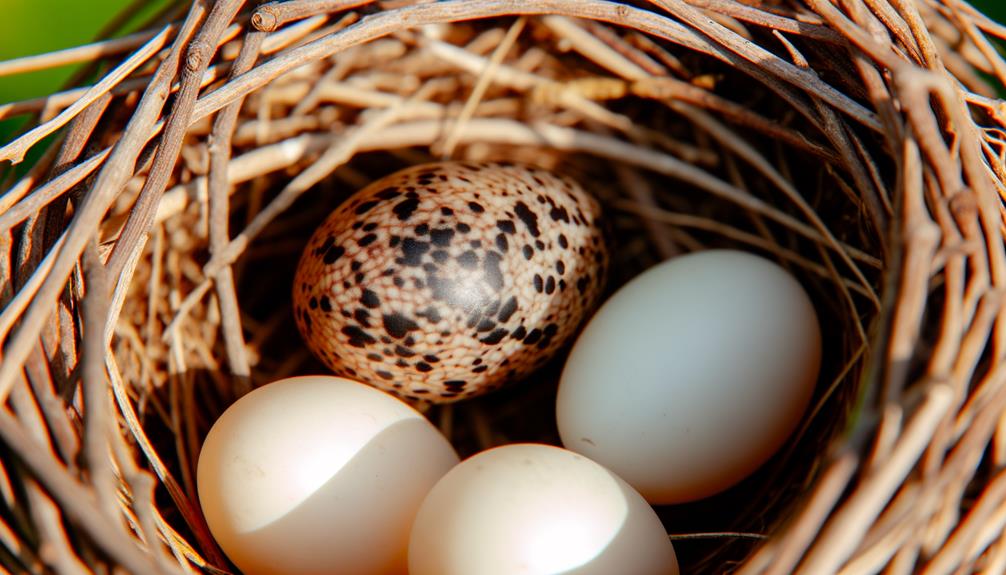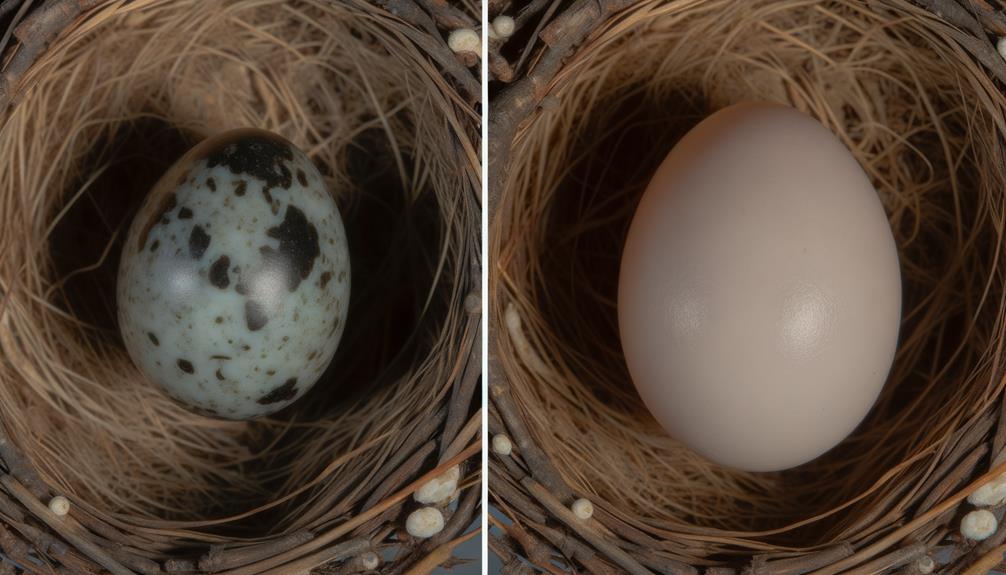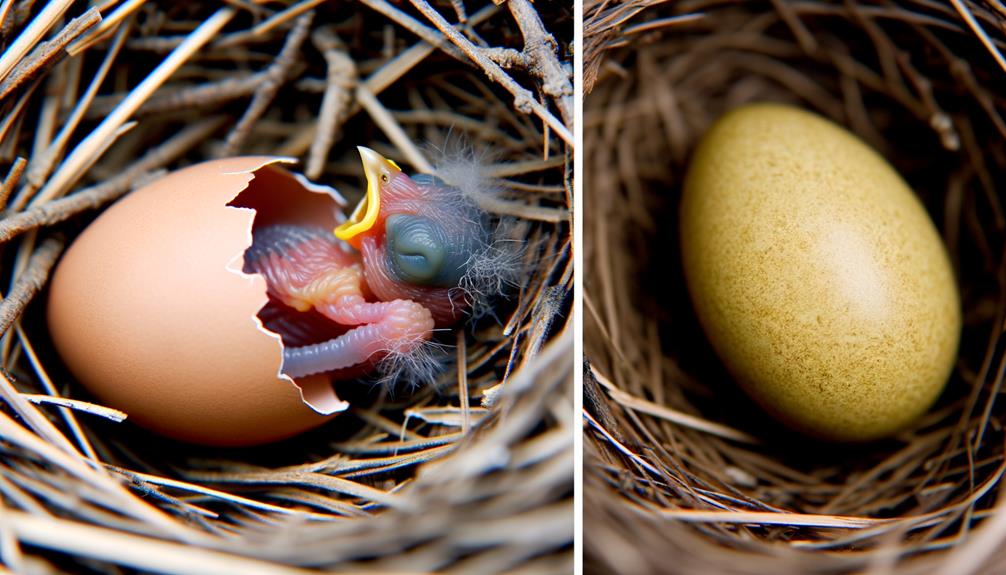3 Key Differences: Cowbird Eggs vs Cardinal Eggs
Cowbird eggs are larger than cardinal eggs, with a creamy white or grayish base and varying speckling patterns. In comparison, cardinal eggs are smaller, ranging in color from whitish to greenish with brown or gray speckles.
Cowbirds are brood parasites, laying their eggs in other birds' nests, leading to increased energy expenditure and reduced survival rates for host chicks. Cardinals build well-concealed nests, but the presence of cowbird eggs often results in nest abandonment.
Therefore, the interplay between cowbird and cardinal eggs reveals complex survival strategies. Continue on to uncover these fascinating dynamics and their ecological significance.

Key Takeaways
- Cowbird eggs are larger (24 mm length, 18 mm width) compared to cardinal eggs (23 mm length, 17 mm width).
- Cowbird eggs are glossy with creamy white or grayish bases and speckling, whereas cardinal eggs range from whitish to greenish with brown or gray speckles.
- Cowbirds practice brood parasitism, laying eggs in cardinal nests, which impacts cardinal chick survival due to competition for food and care.
- Cardinals may abandon nests with cowbird eggs, negatively affecting the reproductive success of their own offspring.
- Cowbird eggs have a shorter incubation period than cardinal eggs, leading to earlier hatching and a competitive advantage for cowbird chicks.
Cowbird Egg Appearance

Cowbird eggs are frequently characterized by their creamy white or grayish base color, speckled with brown or gray spots. You'll notice that these eggs have a somewhat glossy finish, making them distinguishable in a nest.
Typically, their size ranges from 20 to 24 millimeters in length and about 16 to 18 millimeters in width. The speckling pattern can vary significantly, from dense to sparse, providing camouflage in various nesting environments.
Understanding these features helps you identify cowbird eggs in the wild. Their distinctive appearance results from evolutionary adaptations that promote survival by blending into the host's nest, reducing the chance of being detected and removed.
This knowledge empowers you to recognize cowbird eggs accurately and appreciate their unique ecological role.
Cardinal Egg Characteristics
You'll notice that cardinal eggs are generally smaller and more oval-shaped compared to cowbird eggs. They exhibit color patterns ranging from whitish to greenish with speckles of brown or gray.
Cardinals typically lay their eggs in well-concealed nests, often built in dense shrubs or low tree branches.
Size and Shape
A cardinal's egg is typically oval-shaped and measures about 2.2 to 2.9 centimeters in length. You'll notice that these eggs exhibit a consistent shape, making it easier to identify them.
Here are key characteristics to observe:
- Length Range: Cardinal eggs measure between 2.2 to 2.9 cm, providing a reliable size range for identification.
- Width: The width of cardinal eggs generally falls between 1.6 to 2.2 cm, giving them a notably oval shape.
- Shell Texture: The eggs have a smooth texture, which is a common trait among many bird species.
Color Patterns
Cardinal eggs typically exhibit a creamy white base color, often speckled with reddish-brown or gray spots that help them blend into their natural surroundings. These spots vary in density and distribution, providing a unique pattern for each egg.
You'll notice that the speckles are usually concentrated more heavily at the larger end of the egg, creating a gradient effect. This coloration acts as camouflage, protecting the eggs from potential predators.
The eggs measure about 2.2 to 2.7 centimeters in length and 1.6 to 1.9 centimeters in width, fitting snugly within the nest. Their subtle hues and patterns make them less conspicuous, enhancing their survival chances.
Understanding these characteristics can deepen your appreciation for the intricacies of avian reproduction.
Nesting Habits
Cardinals meticulously construct their nests in dense shrubs or low tree branches, ensuring a secure environment for their eggs. They use twigs, leaves, and grasses to form a cup-shaped structure. You'll often find cardinal nests well-hidden to protect against predators.
Here's what you should know about cardinal egg characteristics:
- Color: Cardinal eggs typically range from whitish to pale blue or greenish, with brownish spots or speckles.
- Size: Each egg measures about 2.2-2.5 cm in length, providing ample space for embryo development.
- Clutch Size: Cardinals usually lay between 2 to 5 eggs per clutch, optimizing their chances for successful offspring.
These details highlight how cardinals' nesting habits contribute to their reproductive success.
Egg Size Comparison

When comparing the size of cowbird eggs to those of cardinals, you'll notice that cowbird eggs are generally larger, averaging about 24 mm in length and 18 mm in width, whereas cardinal eggs tend to be slightly smaller, typically measuring around 23 mm in length and 17 mm in width.
This slight difference in dimensions might seem negligible but can significantly impact the incubation process and the space required within the nest. The larger size of cowbird eggs allows for more robust development during the embryonic stage. In contrast, the cardinal's slightly smaller eggs adapt well to their specific nesting strategies and environmental conditions.
Understanding these size differences helps you appreciate the nuanced reproductive strategies of these two bird species.
Nesting Habits
When examining the nesting habits of cowbirds and cardinals, you'll find significant differences in their nesting location preferences and egg incubation periods.
Cowbirds are brood parasites, laying their eggs in the nests of other bird species, while cardinals build their own nests in dense foliage.
Additionally, cowbird eggs typically have a shorter incubation period compared to cardinal eggs, impacting the development timeline of the fledglings.
Nesting Location Preferences
Often found in diverse habitats, cowbirds and cardinals exhibit distinct preferences for their nesting locations, driven by their unique reproductive strategies and environmental adaptations.
You'll notice cowbirds are brood parasites, laying their eggs in the nests of other bird species. This strategy eliminates the need for a dedicated nesting site for themselves.
In contrast, cardinals prefer building their own nests, typically in dense shrubs or low trees, ensuring protection and accessibility.
Consider these key points:
- Cowbirds: Utilize host nests, often in open grasslands or forest edges.
- Cardinals: Construct nests in dense foliage, preferring locations 1-15 feet above ground.
- Adaptations: Cowbirds' parasitic nature allows them to exploit various habitats, while cardinals' nesting choices reflect a need for shelter and safety.
Egg Incubation Periods
Cowbird eggs typically have an incubation period of about 10-12 days, during which the host bird unknowingly provides the necessary warmth and protection. You'll find that cowbirds exploit the care of various host species, leaving them to incubate and rear their offspring.
Cardinals, on the other hand, have an incubation period of approximately 11-13 days. The female cardinal diligently tends to her own eggs, ensuring they remain at the right temperature and humidity levels. This period is essential for the development of the embryos.
Understanding these differing incubation periods helps you appreciate the unique reproductive strategies each species employs. It also highlights the parasitic nature of cowbirds versus the dedicated parenting of cardinals.
Brood Parasitism Explained

Brood parasitism, a fascinating survival strategy, involves one bird laying its eggs in the nest of another species, thereby outsourcing parental care to the unsuspecting host. You're looking at a complex interplay of evolutionary tactics and instinctual behaviors.
Cowbirds, for instance, are notorious for practicing brood parasitism. They exploit the nesting efforts of other birds, ensuring their offspring get raised without the investment of their own resources.
Consider these aspects of brood parasitism:
- Egg Mimicry: Parasites often mimic the host's eggs to avoid detection.
- Early Hatching: Parasitic eggs may hatch sooner, giving their chicks a competitive edge.
- Host Manipulation: Parasites sometimes remove host eggs to increase their own chicks' survival chances.
Understanding this strategy underscores nature's intricate survival mechanisms.
Impact on Cardinal Nests
You'll find that nest parasitism by cowbirds greatly affects cardinal nests.
This often leads to decreased offspring survival rates for cardinals as cowbird chicks outcompete them for food.
Consequently, the reproductive success of cardinals can be severely compromised.
Nest Parasitism Effects
Nest parasitism by cowbirds greatly disrupts the reproductive success of cardinal populations by decreasing the survival rates of their chicks. When cowbirds lay their eggs in cardinal nests, they impose several significant burdens on the host birds.
- Energy Drain: Cardinals expend additional energy feeding the larger, more demanding cowbird chicks, often at the expense of their own young.
- Reduced Care: The presence of parasitic eggs can lead to less attentive care for cardinal chicks as parents divide their resources.
- Nest Abandonment: In some cases, cardinals may abandon nests with cowbird eggs, leading to a total loss of their reproductive effort.
These effects collectively hinder the cardinal's ability to raise their offspring successfully, impacting their population stability.
Offspring Survival Rates
Examining the offspring survival rates in cardinal nests reveals a stark contrast between those with and without cowbird parasitism, highlighting the drastic impact on cardinal reproductive success.
When cowbirds lay their eggs in cardinal nests, the cowbird chicks often outcompete cardinal chicks for food and parental attention. You'll notice that cowbird chicks hatch earlier and grow faster, demanding more resources, which can lead to starvation or neglect of cardinal chicks.
Research shows that cardinal nests parasitized by cowbirds experience notably lower survival rates for cardinal offspring compared to non-parasitized nests. This parasitism reduces the cardinals' ability to raise their own young successfully, thereby affecting their population growth and stability.
Understanding this dynamic is essential for efforts to protect cardinal species.
Incubation Periods

The incubation period for cowbird eggs typically ranges from 10 to 12 days, while cardinal eggs usually require 11 to 13 days. You'll notice that cowbird eggs hatch slightly faster, which can influence their survival strategies.
During incubation, several factors are vital:
- Temperature Regulation: Both species need consistent warmth, usually provided by the parent bird.
- Humidity Levels: Maintaining proper humidity is essential for eggshell integrity and successful hatching.
- Parental Attention: Frequent turning of the eggs ensures even heating and prevents the embryo from sticking to the shell.
Understanding these factors helps you appreciate the delicate balance required for successful incubation. The slight difference in incubation periods may impact the dynamics within mixed-species nests, offering a strategic advantage to the cowbird's earlier hatching.
Hatchling Survival Rates
While observing hatchling survival rates, you'll find that cowbird chicks often outcompete their cardinal nestmates due to their earlier hatching and aggressive feeding behaviors. Cowbird hatchlings typically emerge one to two days before cardinal chicks, giving them a significant advantage in securing food provided by the unsuspecting cardinal parents. Their demanding nature and rapid growth can lead to higher mortality rates for the cardinal chicks, which receive less nourishment and parental care.
| Species | Hatching Time Advantage | Survival Rate (%) |
|---|---|---|
| Cowbird | 1-2 days earlier | 70-80 |
| Cardinal | None | 20-30 |
These dynamics underline the competitive edge cowbird chicks possess, drastically affecting the survival prospects of their cardinal nestmates.
Evolutionary Strategies

In response to the parasitic threat posed by cowbirds, cardinals have evolved a range of adaptive strategies to protect their offspring and guarantee the survival of their genetic lineage.
These strategies include:
- Nest Vigilance: Cardinals increase their nest-monitoring activities to detect and remove cowbird eggs promptly.
- Nest Relocation: After detecting a parasitic threat, cardinals often abandon compromised nests and build new ones in different locations.
- Egg Recognition: Cardinals have developed the ability to distinguish between their own eggs and those of cowbirds, allowing them to eject foreign eggs.
These strategies are essential for minimizing the impact of brood parasitism and ensuring that cardinal chicks receive the necessary resources for growth and development.
Ecological Implications
Understanding the ecological implications of cowbird parasitism on cardinal populations requires examining how these interactions influence broader ecosystem dynamics. You'll find that cowbird parasitism reduces cardinal reproductive success by imposing additional caregiving burdens on cardinal parents. This can lead to fewer cardinal fledglings, affecting their population size.
Consequently, the decline in cardinals can disrupt local food webs, as they play roles in seed dispersal and insect control. On the other hand, cowbirds might inadvertently benefit certain plant species by dispersing seeds over wider areas. You should consider that this parasitism can also force cardinal populations to evolve new defense mechanisms, which could alter their behavior and nesting strategies.
Conclusion
You might think that cowbird eggs, with their sneaky parasitism, would spell doom for cardinal eggs. Ironically, it's this very interspecies drama that bolsters the ecosystem's complexity.
Cardinals, despite their smaller, speckled eggs, often outwit cowbirds with superior parental care. The evolutionary tug-of-war between these birds highlights nature's ingenuity.
So, next time you see a cowbird egg in a cardinal's nest, remember—it's not just survival of the fittest; it's survival of the cleverest.






